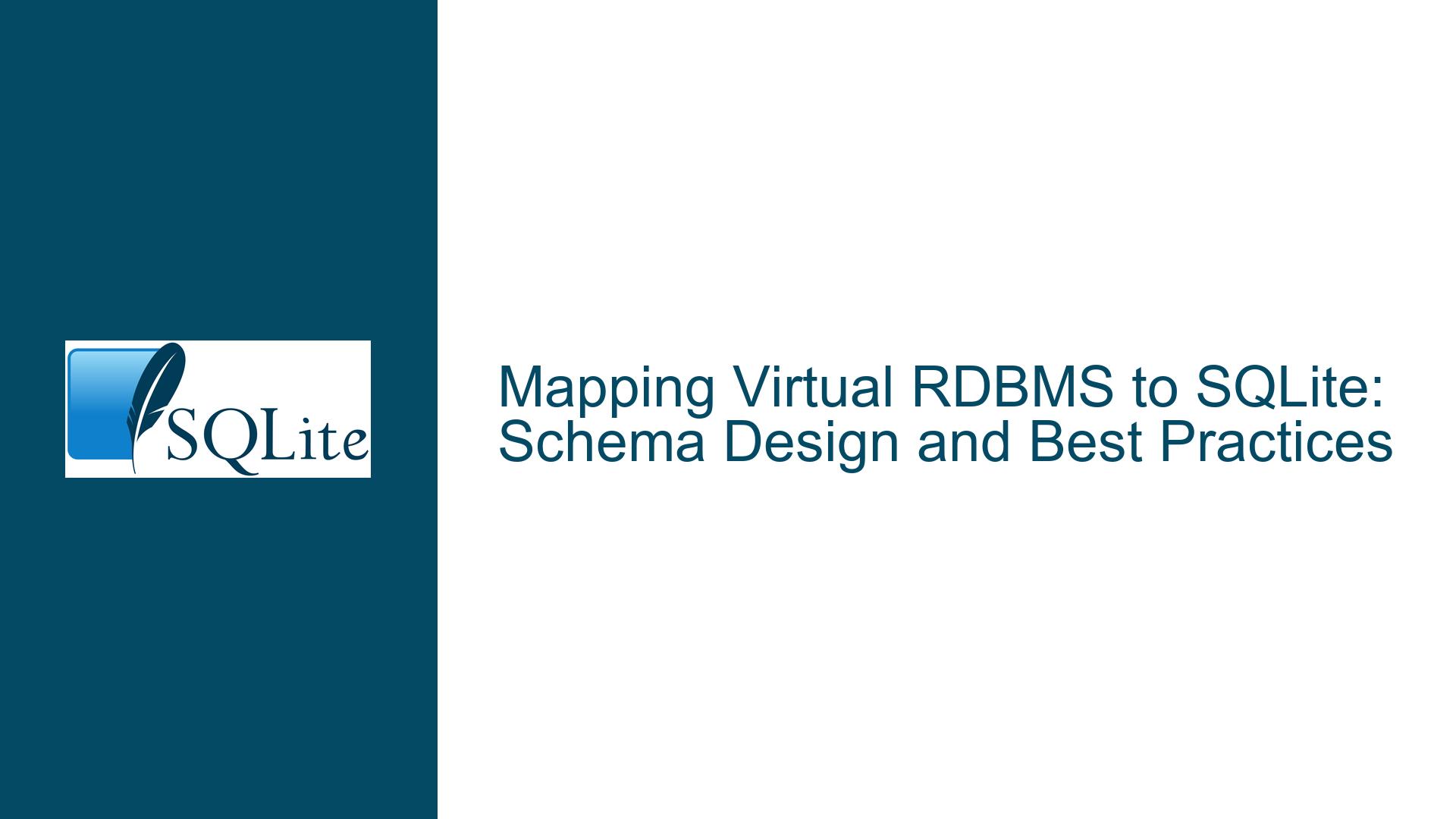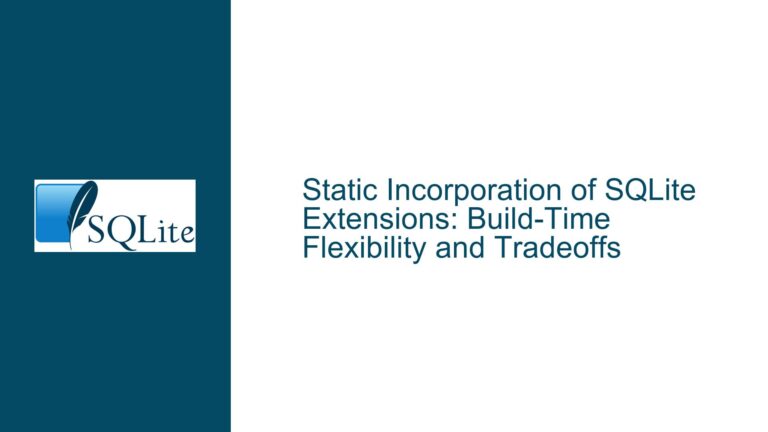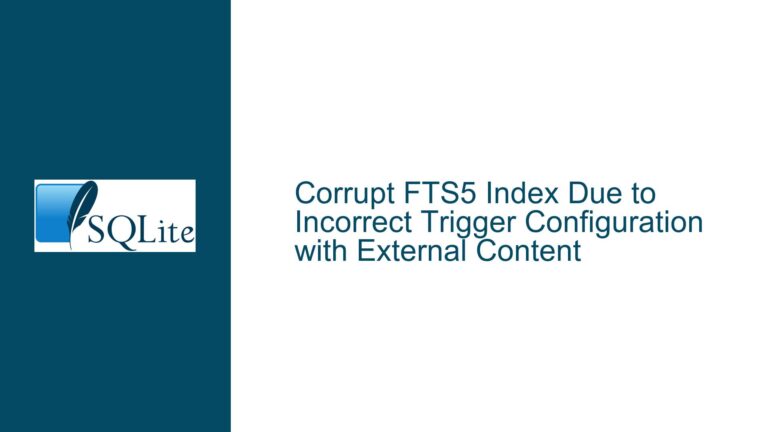Mapping Virtual RDBMS to SQLite: Schema Design and Best Practices
Virtual RDBMS Schema Design and SQLite Integration
The core issue revolves around designing a virtual relational database management system (RDBMS) that operates on top of SQLite. The goal is to create a user-friendly, no-SQL-like command language that interacts with relational data stored in SQLite. The primary challenge is determining the most efficient and scalable way to map user-created virtual databases to SQLite’s underlying schema. The discussion highlights concerns about schema flexibility, column limitations, and the transactional nature of SQLite. The proposed solution involves using a single table with a fixed schema, similar to the approach used in Windows SharePoint Services (WSS) 2007, but this raises questions about scalability, flexibility, and whether SQLite is the right choice for this task.
The discussion also touches on the advantages and disadvantages of using a single-table design versus multiple tables, as well as the implications of SQLite’s transactional DDL (Data Definition Language) capabilities. Additionally, there is a debate about the popularity and practicality of single-table databases, with some participants arguing against their widespread use and others suggesting they are sometimes used in key-value stores. The overarching question is whether SQLite can handle the proposed virtual RDBMS design efficiently, and if so, what schema design would best support the system’s requirements.
Challenges with Single-Table Schema and Column Limitations
One of the primary concerns raised in the discussion is the use of a single-table schema, as seen in WSS 2007, where all user data is stored in a massive table with predefined columns for integers, strings, booleans, and other data types. This approach has several limitations, including a hard cap on the number of columns per table (e.g., 64 columns), which restricts the flexibility of user-created tables. While this design simplifies schema management by avoiding frequent DDL operations, it sacrifices scalability and adaptability. Users cannot create tables with more than the predefined number of columns, and the schema becomes rigid, making it difficult to accommodate evolving data requirements.
Another issue with the single-table approach is the potential for wasted storage space. Since the table must accommodate the maximum number of columns for all possible user tables, many columns will remain unused for most records, leading to inefficient storage utilization. This is particularly problematic in SQLite, which is designed to be lightweight and efficient. The single-table design also complicates querying and indexing, as the database must handle a large number of nullable columns and dynamically interpret their meanings based on metadata stored in auxiliary tables.
The discussion also highlights the transactional nature of SQLite’s DDL operations, which allows for schema changes to be performed atomically. This is a significant advantage over some other databases, where schema changes may require downtime or complex migration procedures. However, the single-table design negates this advantage by avoiding DDL operations altogether, which raises questions about whether this approach is the best fit for SQLite.
Optimizing SQLite for Virtual RDBMS: Schema Design and Query Performance
To address the challenges of mapping a virtual RDBMS to SQLite, it is essential to consider alternative schema designs that balance flexibility, scalability, and performance. One approach is to use multiple tables, with each user-created table mapped to a separate SQLite table. This design allows for unlimited columns and avoids the storage inefficiencies of the single-table approach. However, it introduces the complexity of managing a dynamic schema, as new tables and columns must be created on the fly as users define them.
SQLite’s transactional DDL capabilities make this approach feasible, as schema changes can be performed atomically without risking data corruption. However, managing a large number of tables can impact performance, as SQLite is optimized for handling many rows rather than many tables. While SQLite can handle hundreds or even thousands of tables without significant issues, it is essential to monitor performance and consider sharding the database across multiple files if the number of tables grows too large.
Another consideration is the use of SQLite’s JSON1 extension, which allows for the storage and querying of semi-structured data. This could be a viable alternative to the single-table design, as it provides the flexibility to store varying data structures without requiring a fixed schema. However, this approach may not be suitable for all use cases, particularly those requiring strict relational integrity or complex queries.
In conclusion, the best approach for mapping a virtual RDBMS to SQLite depends on the specific requirements of the system. While the single-table design offers simplicity and avoids DDL operations, it comes with significant limitations in terms of flexibility and scalability. Using multiple tables or leveraging SQLite’s JSON1 extension may provide a more robust solution, but these approaches require careful consideration of performance and schema management. Ultimately, SQLite is a strong candidate for the task, provided that the schema design is carefully optimized to balance the needs of the virtual RDBMS with the strengths and limitations of SQLite.





